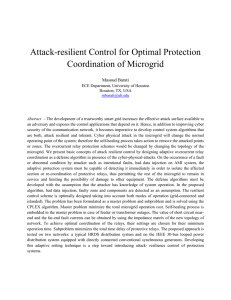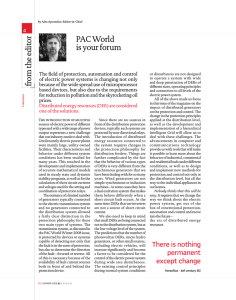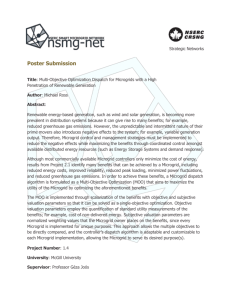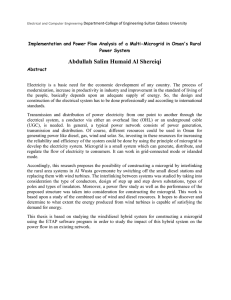Comparison of Three Numerical Optimization Approaches in
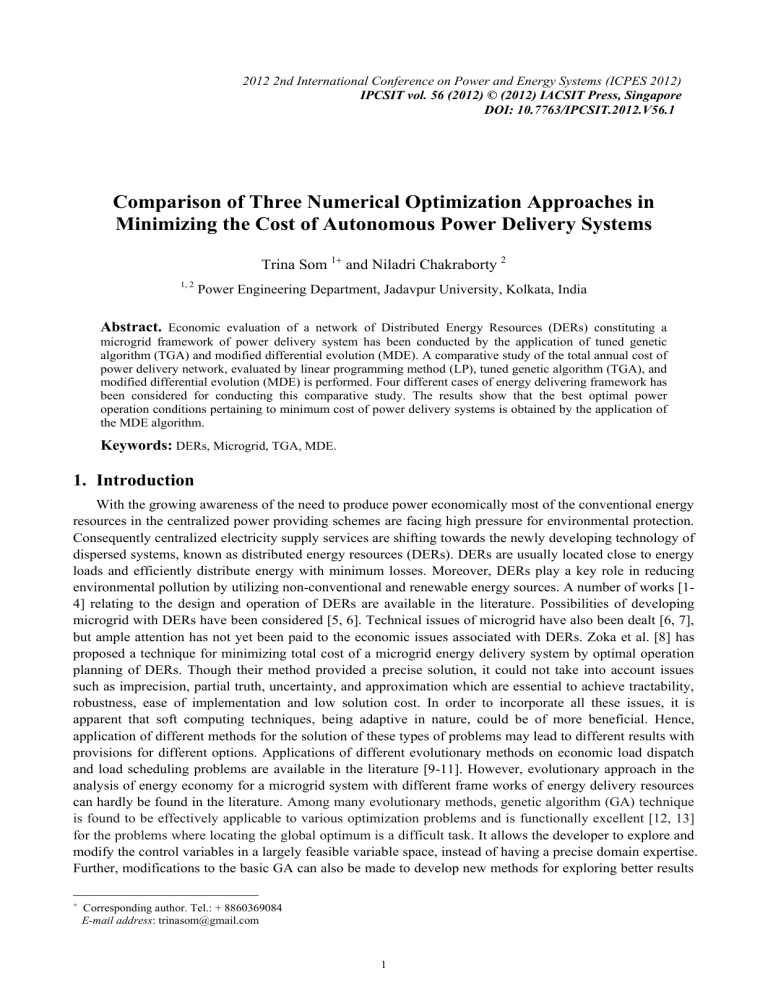
2012 2nd International Conference on Power and Energy Systems (ICPES 2012)
IPCSIT vol. 56 (2012) © (2012) IACSIT Press, Singapore
DOI: 10.7763/IPCSIT.2012.V56.1
Comparison of Three Numerical Optimization Approaches in
Minimizing the Cost of Autonomous Power Delivery Systems
Trina Som
1
and Niladri Chakraborty
2
1, 2
Power Engineering Department, Jadavpur University, Kolkata, India
Abstract.
Economic evaluation of a network of Distributed Energy Resources (DERs) constituting a microgrid framework of power delivery system has been conducted by the application of tuned genetic algorithm (TGA) and modified differential evolution (MDE). A comparative study of the total annual cost of power delivery network, evaluated by linear programming method (LP), tuned genetic algorithm (TGA), and modified differential evolution (MDE) is performed. Four different cases of energy delivering framework has been considered for conducting this comparative study. The results show that the best optimal power operation conditions pertaining to minimum cost of power delivery systems is obtained by the application of the MDE algorithm.
Keywords:
DERs, Microgrid, TGA, MDE.
1.
Introduction
With the growing awareness of the need to produce power economically most of the conventional energy resources in the centralized power providing schemes are facing high pressure for environmental protection.
Consequently centralized electricity supply services are shifting towards the newly developing technology of dispersed systems, known as distributed energy resources (DERs). DERs are usually located close to energy loads and efficiently distribute energy with minimum losses. Moreover, DERs play a key role in reducing environmental pollution by utilizing non-conventional and renewable energy sources. A number of works [1-
4] relating to the design and operation of DERs are available in the literature. Possibilities of developing microgrid with DERs have been considered [5, 6]. Technical issues of microgrid have also been dealt [6, 7], but ample attention has not yet been paid to the economic issues associated with DERs. Zoka et al. [8] has proposed a technique for minimizing total cost of a microgrid energy delivery system by optimal operation planning of DERs. Though their method provided a precise solution, it could not take into account issues such as imprecision, partial truth, uncertainty, and approximation which are essential to achieve tractability, robustness, ease of implementation and low solution cost. In order to incorporate all these issues, it is apparent that soft computing techniques, being adaptive in nature, could be of more beneficial. Hence, application of different methods for the solution of these types of problems may lead to different results with provisions for different options. Applications of different evolutionary methods on economic load dispatch and load scheduling problems are available in the literature [9-11]. However, evolutionary approach in the analysis of energy economy for a microgrid system with different frame works of energy delivery resources can hardly be found in the literature. Among many evolutionary methods, genetic algorithm (GA) technique is found to be effectively applicable to various optimization problems and is functionally excellent [12, 13] for the problems where locating the global optimum is a difficult task. It allows the developer to explore and modify the control variables in a largely feasible variable space, instead of having a precise domain expertise.
Further, modifications to the basic GA can also be made to develop new methods for exploring better results
Corresponding author. Tel.: + 8860369084
E-mail address : trinasom@gmail.com
1
in such optimization problems. However, application of such techniques to optimal operation of DERs resulting in cost minimization is rare.
Again differential evolution (DE) is an evolutionary method which helps to achieve the true global optimum solution using few control parameters regardless of initial parameter values [14]. Moreover, DE is able to mitigate the drawback of long computational time, which makes it a promising approach for engineering optimization. Modifications to the basic DE algorithm can also be made to overcome occasional problems of premature convergence and deterioration in the performance with the growth of dimensionality of the search space for exploring better results in such optimization problems. An improved performance can be predicted by tuning the control parameters of basic
DE as shown in [15].
However, application of this technique to solve economic problems that include microgrid and DER is sparse in the literature. In the present work, authors have developed tuned genetic algorithm (TGA) and modified differential evolution (MDE) and implemented these techniques for economic evaluation of a microgrid power delivery network through optimal power operation planning of
DERs. The application of TGA and MDE is made for four specific cases related to energy economy [8]. A comparative study of the total annual cost of the power delivery cases, evaluated by TGA, MDE, and LP [8] has been depicted
.
2.
Problem Formulation for Economic Evaluation
The power delivery systems in the present problem refer to four test cases by considering six types of consumers [8]. The cases are as follows;
I.
Consumers do not form any microgrid system and each of them makes a separate contract with the utility, without optimally installing DERs.
II.
Each consumer includes the optimal operation of DERs. Hence, the consumers do not form microgrid and makes contract with utility separately.
III.
The consumers form a microgrid, by installing a distributed energy resources. Optimal operation of DERs has been considered without purchasing any electricity from the utility.
IV.
The microgrid is formed by the consumers. All loads within the microgrid optimally operate the
DERs. Purchasing electricity from the utility has also been taken into account.
The reliability of power delivery system is accounted through a power interruption cost along with a provision of purchase and sell of electricity in contract with utility. Economic evaluation is performed by minimizing total annual cost subject to the physical constraints of optimal power generation planning and range of the capacity of DERs.
2.1.
Objective Function
The objective function that refers to the total annual cost of consumer is expressed in (1) as;
Y
Y
Y
Y
Y
Y
O I U MC PI
(1) where Y
O
is the operating cost of DER and is expressed in (2) as;
Y
O cs
1
Ds h
1
( O ) P fc fc
O ) P hs hs
O ) P
ESS ESS
where O fc
, O hs
and O
ESS
are the running cost of fuel cell, heat source, and energy storage system respectively; while P fc
, P hs
, and P
ESS
are power generation from fuel cell, heat source, and energy storage system respectively. D s
represent the number of days per season.
cs , s and h are the consumer, season and time index respectively.
The term Y
I
in (1) is the initial cost of all the DERs and is expressed in (3) as;
Y
I
cs n
1
IC fc
Ci fc
( )
IC hs
Ci hs
( )
IC
ESS
Ci
ESS
(3)
2
The annual depreciation rates of fuel cell, heat source, and energy storage system are denoted as
α
,
β
,
γ respectively. The expression for calculation is shown in (4) as;
I
R
(1
I
R
)
Lt
, , (4)
[(1
I
R
)
Lt
, ,
1]
where I
R is the rate of interest, and Lt is the lifetime of DERs.
The cost related to the utility is Y
U
as shown in (5);
Y
U
cs n
1 s m
1
Ds h t
1
r 1 p
( , , )
e r 2
P sl h s cs
max P p
( , )
(5) where e r1
, e r2
, and e b
are the purchase, sell and base rate of electricity respectively, and P
P
, P sl
are the amount of power purchased and sold respectively.
The microgrid constructional cost is defined as Y
MC
in (6) as;
Y
MC
C
SD
C
EM
C dl
C cl
(6)
Microgrid construction includes energy manager, separating devices, distribution line and communication line, whose depreciation rates are
δ, η, λ, σ
respectively, and are calculated by the same equation as in (4). The power interruption cost is termed as Y
PI and it is expressed in (7) as;
Y
PI
120
10 d c c 1
2
( , , )
IC fc
( cs )
IC hs
( cs )
(7)
The power interruptions cost depends mainly on the duration of power interruption, the type of consumers and geographical issues. The types of consumers have been characterized by certain parameters, i.e. c1 and c2 for this cost calculation. D
E
is the load demand and prob ( h ) is the probability of interruption.
IC is the installed capacity of DERs. The above mentioned cost functions are subjected to functional and side constraints for the economic cost analysis, as discussed below.
2.2.
Constraining Function
In order to minimize the total cost expressed in (1), the balanced power demand-supply operation planning of DERs are considered as the main functional constraint as described in (8). cs n
1
D E h s cs )
P fc h s cs
P hs h s cs
P ESS h s cs ( , , )
P p h s cs
P sl h s cs
(8)
The other side constraining functions include the range of upper and lower limits of power output of fuel cell heat source and energy storage system to be within zero to their respective installed capacity and all the variables are positive.
3.
Solution Methodologies
The numerical tools namely, TGA and MDE developed for the economic analysis of power delivery systems are explained below in section 3.1 and 3.2 respectively.
3.1.
Development of tuned genetic algorithm (TGA)
A modification to the conventional genetic algorithm [12] is made by replacing the individuals of the population with individuals corresponding to the highest fittest value between two consecutive iterations in order to have a better population set of solutions. This tuning procedure continues until the difference between the fittest values as computed at the end of every generation from that of its previous one reaches to
3
the defined tolerance value. The modified algorithm is named Tuned Genetic Algorithm (TGA). The implementation logic is briefly described in the following steps.
Step I: In this step, a population is created to initialize population. These population matrices pertain to the as P h 1 fc generation
P hi fc
, .....
, ......
P hN fc
of
, P h 1 hs power
,.....
P hi hs
, ......
by
P hN hs
,
DG,
P h 1
ESS
, ....
P hi battery,
ESS
, .....
P hN
ESS which
are defined
respectively. The matrices are varied for h hours of power demand, with a population size of N for different consumers. The individual elements of the defined matrices are represented as single matrix in terms of cost as;
Y h 1
, ,
Y h 2
, ,
Y h 3
, ,
....
Y hi
, ,
.....
Y hN
, ,
. On the basis of this matrix the best fitness value is calculated. Step II: Evolutionary operations for each individual in the population are carried out by the operations of selection, crossover and mutation, which are described in the following subsections. Step III:
The fitness value is calculated after evaluating the population set. This fitness value is now compared with previous fitness value of the initial population set. The best fitness value is selected for creation of next generation population. The corresponding individuals relating to the best fitness value are selected for the next iteration. Step IV: The iteration procedure is continued until the termination condition. This is based on the tolerance value which is considered as the negligible difference between the highest fitness values of consecutive iterations.
3.2.
Development of modified differential evolution (MDE)
A population of solution vectors is successively updated through differential evolution algorithm (DE) as given in [14]. Modification over DE involves by combining the information of the best solution in the population and thereby increasing the probability of generating better offspring using different mutation operators. A consideration of improved variants of DE [15] which utilizes the concept of neighborhood of each population member, balances the exploration and exploitation abilities of DE without imposing additional burden in terms of function evaluations. The application of this algorithm to this problem is
DG DG DG
hs hs hs explained as follows; Step I: Let P h 1
,.....
P hi
,......
P hN and P h 1 ps
,.....
P hi
, ......
P hN be the ps ps ps ps ps initial solutions relating to power generation from DG and BESS respectively. The solutions relating to the number of variables in the objective function ( P
DG
, P
BT
,P
SO etc.
) together form a matrix pool having a population size of ps . Step II: Three sets of element matrix are chosen randomly from the pool of total population matrix [15]. Each encoded individuals form a mutant vector and new variables are found from the following equation;
best
- x r2
r1
(9)
Where ps
, is the original set of elements in the trial vector, and X ,X ,..........X
ps
is the mutated set of elements. F
α and F
β are the mutation factors and their dynamic ranges usually lie from 0.7 to 0.9 and 0.1 to 0.3, respectively [15]. These sets of encoded individuals are chosen through a defined rule, where three distinct rows r
1
, r
2
, and r
3
are randomly chosen provided r
1
≠ r
2
≠ r
3
. Moreover, each random pick is done between all the rows of elements’ vector, leaving one different row at every pick. Thus the number of picks exactly matches the population size, such that modified mutated set of elements are calculated for all the rows in the trial vector and the mutated vector becomes as
2 ps
. Step IV:
Next, the crossover and selection operations are performed by the application of operators and all the above four steps are repeated until all the rows in the trial matrix go through the random selection, mutation and crossover process. Step V: The iteration procedure is continued until the termination criterion, i.e. the difference between the best fitness values of consecutive iterations becoming negligible is satisfied.
4.
Results
Four cases of different energy delivering framework along with its input parameters as mentioned in [8] have been considered in presenting this comparative picture. The results compared by three techniques for case I and case II are given below in Table 1. Table 2 presents the comparative picture for cases III and IV.
4
Table. 1: Comparative Study of Results for Different Consumers for case I and case II
Table. 2: Comparative Study of Results for Different Consumers for all the four cases
It is observed from table 1 and 2 that consumers’ cost corresponding to optimal power distribution, obtained after implementation of MDE, becomes always less under all situations as compared to those obtained by LP method [8] and tuned genetic algorithm (TGA). The reduction of cost for case I and case II varies with the type of consumers. Cost Reduction of 1.9 %, 2.1 %, 1.3 % and 0.8 % have been obtained by implementing
MDE for the four cases respectively as that computed by TGA, while these reductions in comparison to that obtained by LP are 8.4 % , 7.4 %, 7.7 % and 9.2 % respectively. Though in case 1, cost evaluated by TGA is obtained lowest for some consumers, but the best optimal operation of DERs pertaining to cost minimization was obtained by MDE for all the four cases. Further, it has noticed that for all the four cases, total cost evaluated by soft computing techniques (TGA and MDE) resulted less from that evaluated by LP.
5.
Conclusion
DERs connected to a microgrid frame work have been evaluated from an economic perspective using
TGA and MDE.
Economically best optimized operational condition of DERs has been obtained by the application of MDE. The application of both TGA and MDE for the above mentioned cases leads to a subsequent reduction of total cost as compared to that obtained by LP method. Hence these methods have been observed to provide better solutions in the critical and complex real world problems instead of traditional method like LP [8]. Moreover, from the relative picture of TGA and MDE in cost analysis it can be concluded that MDE works better in this type of optimization problem in comparison to TGA.
6.
References
[1] C. A. Hernandez-Aramburo, T. C. Green, N.Mugniot, Fuel consumption minimization of a microgrid. IEEE Trans.
Ind Appl , 41(3), 2005, pp. 673–681
[2] C. Marnay, G. Venkataramanan, M. Stadler, A. Siddiqui, R. Firestone, B. Chandran. Optimal Technology Selection and Operation of Commercial-Building Microgrids. IEEE Trans. power systems. 23(3), 2008, pp. 975.
[3] H. Michiel, H. Petra, I. Bouwmans. Socio-Technical Complexity in Energy Infrastructures Conceptual Framework to Study the Impact of Domestic Level Energy Generation, Storage and Exchange. IEEE Int Conf. Systems Man, and Cybernetics . 2006, pp. 8 -11.
[4] M. Maribua, K. Firestone, M. Ryan, C. Marnay, A. Siddiquica. Distributed energy resources market diffusion
5
model. Elsevier Energy Policy . (April 2007), pp. 4471-4484.
[5] S. Watson, R. Fredericksen, T. Lorencz. Chicago Power Park Project, Monthly Status Report. 2001. Available
[online]: http://www.nemw.org/
[6] F. Marin, A. Rey, A. Guerrero, F. Ruz. A future microgrid implementation based on renewable distributed resources for a clean green energy production, Proc. IEEE PES Winter Meeting, CERTS , 2002, pp. 305-308.
[7] A. Meliopoulos. Challenges in Simulation and Design of Grids. Proc. IEEE PES Winter Meeting.
2002, pp. 309–
314.
[8] Y. Zoka, A. Sugimoto, N. Yorino, K. Kawahara, J. Kubokawa. An economic evaluation for an autonomous independent network of distributed energy resources. Electric Power System Research , (77)7, 2007, pp. 831 – 838.
[9] I. Farhat, M. EI-Hawary. Optimization methods applied for solving the short-term hydrothermal co–ordination problem. Electric Power System Research . 79(9), 2009.
[10] K. Mandal, M. Basu, N. Chakraborty. Particle swarm optimization – based fuzzy satisfying method for economic environmental dispatch of hydrothermal power systems. International Journal of Automation and Control.
(3),
2009, pp. 216 – 239
[11] M. AlRashidi, M. EI- Hawary. Application of computational intelligence techniques for solving the revived optimal power flow problem. Electric Power System Research . 79(4), 2009, pp. 694-702.
[12] A. Dias, J. de Vasconcelos. Multiobjective genetic algorithms applied to solve optimization problems. IEEE
Transactions on Magnetics . 2002, 38(2), pp. 1133–1136
[13] J. Hermann. A genetic algorithm for minimax optimization problems. Proc. of the Congress on Evolutionary
Computation, Washington DC: 1999
[14] K. Price. An introduction to differential evolution New Ideas in Optimization , McGraw-Hill, 1999.
[15] M. Mezura, J. Velazquez, C. Coello Coello. Modified Differential Evolution of Constrained Optimization , IEEE
Congress on Evolutionary Computation Sheraton , 2006.
6


